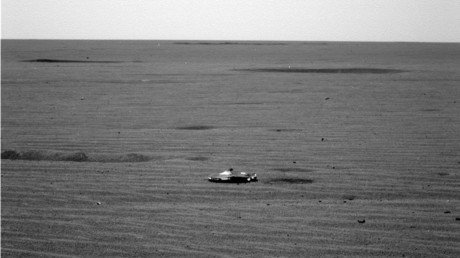'This is a great surprise’: NASA’s OSIRIS-REx has already discovered WATER on Bennu

Just days after NASA’s OSIRIS-REx spacecraft reached the distant asteroid Bennu, it has already sent back groundbreaking data revealing the asteroid contains water.
Less than a week after completing the two-year, 1.2 billion mile journey from Earth to Bennu, the OSIRIS-REx (Origins, Spectral Interpretation, Resource Identification, Security-Regolith Explorer) has revealed Bennu is “water rich.”
Which brings us to something big... We found water on Bennu! ☄️💦 Two of my spectrometers – OVIRS and OTES – detected the chemical fingerprints of water bound up in hydrated clay minerals over a large part of the asteroid’s surface. #WelcomeToBennu#AGU18https://t.co/PJC8agBLEEpic.twitter.com/F74s8dGIIl
— NASA's OSIRIS-REx (@OSIRISREx) December 10, 2018
Bennu is some 100 million miles (160 million kilometers) from the sun and scientists hoped it would shed further light on our understanding of the solar system, but they didn’t anticipate a breakthrough so soon.
The spacecraft found “the chemical fingerprints of water bound up in hydrated clay minerals over a large part of the asteroid’s surface,” NASA said. It used its onboard spectrometers, which can determine the chemical composition of an area, to make the discovery.
This means water was present on the 1,600-foot-wide (487-meter) asteroid, and a lot of it.
There is strong convincing evidence that the surface is dominated by these hydrated minerals,” said Dante Lauretta, leader of OSIRIS-REx’s sample return mission.
READ MORE: Biological viruses could hold key to super-fast supercomputers
“These hydrated minerals are evidence of liquid water in Bennu’s past,” OSIRIS-REx team member Amy Simon said.
Bennu also has a number of 50 meter boulders on its surface, with at least one estimated to be 115 feet wide. The probe also saw a 60 meter wide crater on its surface.
On Dec. 2 at a range of 15 miles (24 km), PolyCam snapped this image showing three different boulder features on Bennu, each circled in white and then magnified. 📸 🔍Their widths are about 52 feet (16 m), 115 feet (35 m), and 102 feet (31 m), respectively. #WelcomeToBennu#AGU18pic.twitter.com/80XgulZiT1
— NASA's OSIRIS-REx (@OSIRISREx) December 10, 2018
“[The boulders] seem to be resting right on the surface like they fell back on, or something weathered around them, and left them exposed,” Lauretta said.
OSIRIS-REx is part of NASA’s Origins Program and its mission is to learn more about asteroids and glean further understanding about how planets are formed.
READ MORE: New moons & stormy planets: Voyager 2’s greatest discoveries (PHOTOS, VIDEO)
It will collect at least two ounces of samples from Bennu and bring it back to Earth in 2023. OSIRIS-REx will start to orbit Bennu on December 31, making it the smallest object ever orbited by a spacecraft.
Members of the OSIRIS-REx mission team will answer questions about the findings on Twitter on Tuesday from 3 – 4 pm ET, using #BennuChat.
If you like this story, share it with a friend!















